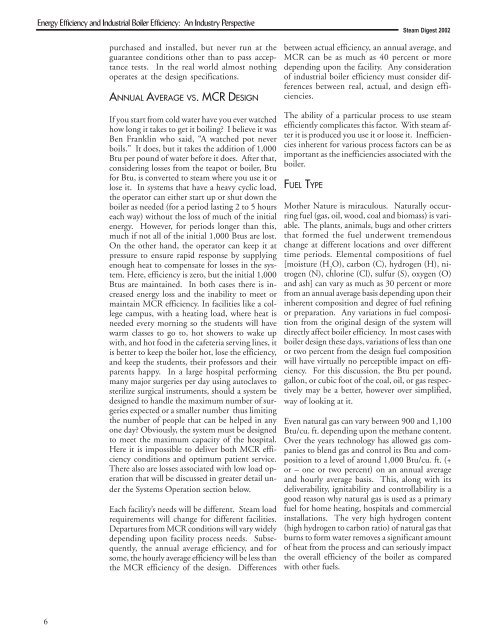Steam Digest 2002 - CiteSeerX
Steam Digest 2002 - CiteSeerX
Steam Digest 2002 - CiteSeerX
You also want an ePaper? Increase the reach of your titles
YUMPU automatically turns print PDFs into web optimized ePapers that Google loves.
Energy Efficiency and Industrial Boiler Efficiency: An Industry Perspective<br />
6<br />
purchased and installed, but never run at the<br />
guarantee conditions other than to pass acceptance<br />
tests. In the real world almost nothing<br />
operates at the design specifications.<br />
ANNUAL AVERAGE VS. MCR DESIGN<br />
If you start from cold water have you ever watched<br />
how long it takes to get it boiling? I believe it was<br />
Ben Franklin who said, “A watched pot never<br />
boils.” It does, but it takes the addition of 1,000<br />
Btu per pound of water before it does. After that,<br />
considering losses from the teapot or boiler, Btu<br />
for Btu, is converted to steam where you use it or<br />
lose it. In systems that have a heavy cyclic load,<br />
the operator can either start up or shut down the<br />
boiler as needed (for a period lasting 2 to 5 hours<br />
each way) without the loss of much of the initial<br />
energy. However, for periods longer than this,<br />
much if not all of the initial 1,000 Btus are lost.<br />
On the other hand, the operator can keep it at<br />
pressure to ensure rapid response by supplying<br />
enough heat to compensate for losses in the system.<br />
Here, efficiency is zero, but the initial 1,000<br />
Btus are maintained. In both cases there is increased<br />
energy loss and the inability to meet or<br />
maintain MCR efficiency. In facilities like a college<br />
campus, with a heating load, where heat is<br />
needed every morning so the students will have<br />
warm classes to go to, hot showers to wake up<br />
with, and hot food in the cafeteria serving lines, it<br />
is better to keep the boiler hot, lose the efficiency,<br />
and keep the students, their professors and their<br />
parents happy. In a large hospital performing<br />
many major surgeries per day using autoclaves to<br />
sterilize surgical instruments, should a system be<br />
designed to handle the maximum number of surgeries<br />
expected or a smaller number thus limiting<br />
the number of people that can be helped in any<br />
one day? Obviously, the system must be designed<br />
to meet the maximum capacity of the hospital.<br />
Here it is impossible to deliver both MCR efficiency<br />
conditions and optimum patient service.<br />
There also are losses associated with low load operation<br />
that will be discussed in greater detail under<br />
the Systems Operation section below.<br />
Each facility’s needs will be different. <strong>Steam</strong> load<br />
requirements will change for different facilities.<br />
Departures from MCR conditions will vary widely<br />
depending upon facility process needs. Subsequently,<br />
the annual average efficiency, and for<br />
some, the hourly average efficiency will be less than<br />
the MCR efficiency of the design. Differences<br />
<strong>Steam</strong> <strong>Digest</strong> <strong>2002</strong><br />
between actual efficiency, an annual average, and<br />
MCR can be as much as 40 percent or more<br />
depending upon the facility. Any consideration<br />
of industrial boiler efficiency must consider differences<br />
between real, actual, and design efficiencies.<br />
The ability of a particular process to use steam<br />
efficiently complicates this factor. With steam after<br />
it is produced you use it or loose it. Inefficiencies<br />
inherent for various process factors can be as<br />
important as the inefficiencies associated with the<br />
boiler.<br />
FUEL TYPE<br />
Mother Nature is miraculous. Naturally occurring<br />
fuel (gas, oil, wood, coal and biomass) is variable.<br />
The plants, animals, bugs and other critters<br />
that formed the fuel underwent tremendous<br />
change at different locations and over different<br />
time periods. Elemental compositions of fuel<br />
[moisture (H 2 O), carbon (C), hydrogen (H), nitrogen<br />
(N), chlorine (Cl), sulfur (S), oxygen (O)<br />
and ash] can vary as much as 30 percent or more<br />
from an annual average basis depending upon their<br />
inherent composition and degree of fuel refining<br />
or preparation. Any variations in fuel composition<br />
from the original design of the system will<br />
directly affect boiler efficiency. In most cases with<br />
boiler design these days, variations of less than one<br />
or two percent from the design fuel composition<br />
will have virtually no perceptible impact on efficiency.<br />
For this discussion, the Btu per pound,<br />
gallon, or cubic foot of the coal, oil, or gas respectively<br />
may be a better, however over simplified,<br />
way of looking at it.<br />
Even natural gas can vary between 900 and 1,100<br />
Btu/cu. ft. depending upon the methane content.<br />
Over the years technology has allowed gas companies<br />
to blend gas and control its Btu and composition<br />
to a level of around 1,000 Btu/cu. ft. (+<br />
or – one or two percent) on an annual average<br />
and hourly average basis. This, along with its<br />
deliverability, ignitability and controllability is a<br />
good reason why natural gas is used as a primary<br />
fuel for home heating, hospitals and commercial<br />
installations. The very high hydrogen content<br />
(high hydrogen to carbon ratio) of natural gas that<br />
burns to form water removes a significant amount<br />
of heat from the process and can seriously impact<br />
the overall efficiency of the boiler as compared<br />
with other fuels.
















